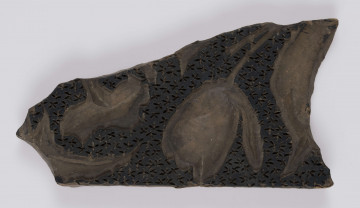
Block for printing on textile
1901 — 1950
National Museum in Lublin
Part of the collection: Fabric printing matrices
Textile printing is a technique for decorating fabrics that came to Europe from the East. From the very beginning textiles printed on the Old Continent were treated as a kind of substitute for expensive and precious fabrics such as satins, brocades and velvets. The development of design found in textile printing was influenced by changing historical styles. Dyers had to follow the latest trends and offer a large selection of designs to meet the tastes of their customers. Printing blocks differed not only in design but also in shape. The most common ones were square-shaped blocks, used for even coverage of large pieces of fabric. Longitudinal, rectangular stamps were dedicated to printing the edges of fabrics, while elliptical or polygonal blocks were used to print single motifs placed centrally or in the corners. The presented specimen with a convex, geometric motif is an example of a stamp used for covering the surface of the fabric with an even pattern. The design consists of small squares forming a compact checkerboard. The classical chequered pattern was not a common motif on printing blocks, but the arrangement of patterns on a checkerboard layout in various ways was quite common. The stamp is one of over a hundred in the collection of the National Museum in Szczecin. It was transferred from the Regional Museum in Białogard that was closed in 1951.
Author / creator
Dimensions
cały obiekt: height: 4,8 cm, width: 19 cm
Object type
matrix
Creation time / dating
Creation / finding place
Identification number
Location / status

1901 — 1950
National Museum in Lublin

1901 — 1950
National Museum in Lublin

1901 — 1950
National Museum in Lublin
DISCOVER this TOPIC
Castle Museum in Łańcut
DISCOVER this PATH
Educational path